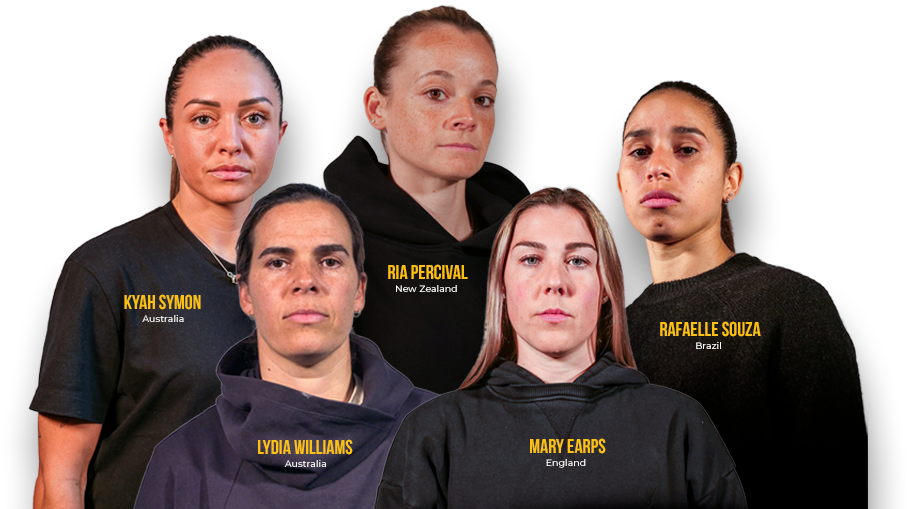





INFORMATION FOR SPORT ORGANISATIONS, COACHES & VOLUNTEERS TO #KEEPKIDSSAFE
INFORMATION FOR SPORT ORGANISATIONS, COACHES & VOLUNTEERS TO #KEEPKIDSSAFE
The safety and well-being of children should always be the top priority in sports clubs and organisations.
No matter what your position within a sporting club or organisation – coach, medic, administrator, participant/player, volunteer, parent or official – as an adult in sport, you have a vital role to play in ensuring that children can enjoy their sport in a protected and safe environment.
Information relating to child safety and protection from abuse and exploitation may bring up strong feelings. Remember, you are not alone. If you need assistance or support, you can access a list of dedicated services on our Finding Help page.
Safeguarding is the way that we keep children safe in sport. Safeguarding in practice involves two key elements: prevention to minimise risk to children and prevent any kind of harm or abuse from happening, and response to concerns that a child is at risk or is suffering harm or abuse.
Those who have child safeguarding concerns in Australian sport, are encouraged to report to Sport Integrity Australia’s Safe Sport Hotline on 1800 161 361 – Open 7am-7pm, 7 Days a Week
Sport NZ has a variety of child protection resources available on their website for those who have a concern or are looking to prevent child abuse or exploitation in sport. Any safeguarding concerns within football in Aotearoa New Zealand in particular can be reported to NZ Football’s email: safeguarding@nzfootball.co.nz
Safeguarding is the way that we keep children safe in sport. Safeguarding in practice involves two key elements: prevention to minimise risk to children and prevent any kind of harm or abuse from happening, and response to concerns that a child is at risk or is suffering harm or abuse.
Those who have child safeguarding concerns in Australian sport, are encouraged to report to Sport Integrity Australia’s Safe Sport Hotline on 1800 161 361 – Open 7am-7pm, 7 Days a Week
Sport NZ has a variety of child protection resources available on their website for those who have a concern or are looking to prevent child abuse or exploitation in sport. Any safeguarding concerns within football in Aotearoa New Zealand in particular can be reported to NZ Football’s email: safeguarding@nzfootball.co.nz
Legal Obligations of Sports Organisations to #KeepKidsSafe
In Australia, all sporting clubs and organisations have a legal duty of care to ensure that anyone who takes part in programs or activities is protected from all reasonably foreseeable risks of harm. This is a common law responsibility that covers both action and inaction. Therefore, every committee member, manager, coach, official, staff member and volunteer have a role in keeping kids safe in sport.
Each state/territory in Australia has child protection legislation specifying the responsibilities for both organisations and individuals that work or have contact with children. These responsibilities include mandatory reporting and background checking, such as police checks or working with children checks.
In Aotearoa New Zealand, organisations working with tamariki have a duty of care to safeguard and protect tamariki from abuse and neglect.
Safeguarding Children has produced a free 30 minute webinar “Child-Safe Organisations” which discusses the core elements of a child-safe organisation. It provides guidance to develop or enhance existing child-safe elements within an organisation.
Legal Obligations of Sports Organisations to #KeepKidsSafe
In Australia, all sporting clubs and organisations have a legal duty of care to ensure that anyone who takes part in programs or activities is protected from all reasonably foreseeable risks of harm. This is a common law responsibility that covers both action and inaction. Therefore, every committee member, manager, coach, official, staff member and volunteer have a role in keeping kids safe in sport.
Each state/territory in Australia has child protection legislation specifying the responsibilities for both organisations and individuals that work or have contact with children. These responsibilities include mandatory reporting and background checking, such as police checks or working with children checks.
In Aotearoa New Zealand, organisations working with tamariki have a duty of care to safeguard and protect tamariki from abuse and neglect.
Safeguarding Children has produced a free 30 minute webinar “Child-Safe Organisations” which discusses the core elements of a child-safe organisation. It provides guidance to develop or enhance existing child-safe elements within an organisation.
Safeguards to Put in Place to #KeepKidsSafe in Sport
There are practical and tangible actions that can and should be followed by anyone involved in the delivery of programmes, services or activities to children participating in sport. By implementing these measures, you can help create a safer environment for children and prevent abuse and exploitation in sports.
1
HAVE A SAFEGUARDING POLICY
A safeguarding policy establishes your organisation’s commitment to protecting children from harm. It clearly lays out proper protocols and definitions for everyone involved – staff, coaches, athletes, volunteers, and partners.
2
KNOW WHAT TO DO IF YOU ARE WORRIED ABOUT A CHILD
Having step-by-step guidance in place in the event of a safeguarding concern means your organisation will know how to respond quickly, properly, and transparently. These procedures range from designating a safeguarding focal point to outlining how concerns are documented and monitored.
3
PROVIDE ADVICE AND SUPPORT TO STAFF AND CHILDREN
Those involved with your organisation deserve to know what their safeguarding role is, and where they can turn to for information and guidance – not only within your organisation, but externally as well. And remember, children with additional vulnerabilities will need additional support.
4
UNDERSTAND AND ADDRESS RISK
If you don’t understand and identify potential risks, you won’t know how to prevent or minimise them. Ongoing risk assessments for activities, transport, accommodation and spaces, and training for staff will help you reduce the possibility of harm, or decide whether to abandon an activity altogether.
5
AGREE WHAT IS ACCEPTABLE AND UNACCEPTABLE BEHAVIOUR
Children’s sport should be carried out in a safe and encouraging environment. Creating and sharing codes of conduct for adults and children sets a safeguarding standard, encourages mutual respect, and promotes best practice among all involved.
6
SAFELY RECRUIT AND TRAIN YOUR STAFF
Everyone within your organisation has a role to play in safeguarding children. By developing a safe recruitment and staff development strategy, you will be able to recruit the right staff members, who will be able to learn and maintain necessary safeguarding skills.
7
SHARE SAFEGUARDING WITH YOUR PARTNERS
Having your partners on board with your safeguarding policy adds an extra layer of protection for children. Setting clear and transparent safeguarding expectations helps create strong and supportive partnerships. You can also encourage and support your partners to strengthen their own approach to safeguarding.
8
MONITOR, EVALUATE AND LEARN
Safeguarding isn’t a one-off process. As you continue on your safeguarding journey, build in time for reassessment in order to understand what’s been effective and what needs improvement.
Further Resources for Sports Organisations
Further resources for sports organisations, coaches and volunteers can be found on Play by the Rules and Sport Integrity Australia’s respective websites.
Safeguards to Put in Place to #KeepKidsSafe in Sport
There are practical and tangible actions that can and should be followed by anyone involved in the delivery of programmes, services or activities to children participating in sport. By implementing these measures, you can help create a safer environment for children and prevent abuse and exploitation in sports.
1
HAVE A SAFEGUARDING POLICY
A safeguarding policy establishes your organisation’s commitment to protecting children from harm. It clearly lays out proper protocols and definitions for everyone involved – staff, coaches, athletes, volunteers, and partners.
2
KNOW WHAT TO DO IF YOU ARE WORRIED ABOUT A CHILD
Having step-by-step guidance in place in the event of a safeguarding concern means your organisation will know how to respond quickly, properly, and transparently. These procedures range from designating a safeguarding focal point to outlining how concerns are documented and monitored.
3
PROVIDE ADVICE AND SUPPORT TO STAFF AND CHILDREN
Those involved with your organisation deserve to know what their safeguarding role is, and where they can turn to for information and guidance – not only within your organisation, but externally as well. And remember, children with additional vulnerabilities will need additional support.
4
UNDERSTAND AND ADDRESS RISK
If you don’t understand and identify potential risks, you won’t know how to prevent or minimise them. Ongoing risk assessments for activities, transport, accommodation and spaces, and training for staff will help you reduce the possibility of harm, or decide whether to abandon an activity altogether.
5
AGREE WHAT IS ACCEPTABLE AND UNACCEPTABLE BEHAVIOUR
Children’s sport should be carried out in a safe and encouraging environment. Creating and sharing codes of conduct for adults and children sets a safeguarding standard, encourages mutual respect, and promotes best practice among all involved.
6
SAFELY RECRUIT AND TRAIN YOUR STAFF
Everyone within your organisation has a role to play in safeguarding children. By developing a safe recruitment and staff development strategy, you will be able to recruit the right staff members, who will be able to learn and maintain necessary safeguarding skills.
7
SHARE SAFEGUARDING WITH YOUR PARTNERS
Having your partners on board with your safeguarding policy adds an extra layer of protection for children. Setting clear and transparent safeguarding expectations helps create strong and supportive partnerships. You can also encourage and support your partners to strengthen their own approach to safeguarding.
8
MONITOR, EVALUATE AND LEARN
Safeguarding isn’t a one-off process. As you continue on your safeguarding journey, build in time for reassessment in order to understand what’s been effective and what needs improvement.
Further Resources for Sports Organisations
Further resources for sports organisations, coaches and volunteers can be found on Play by the Rules and Sport Integrity Australia’s respective websites.




